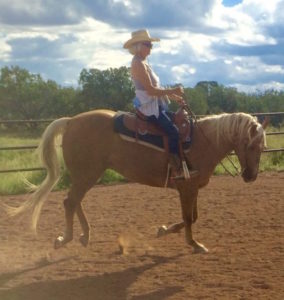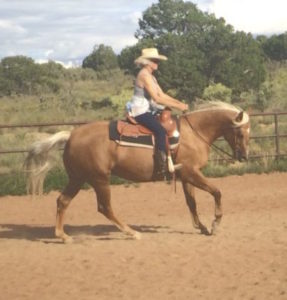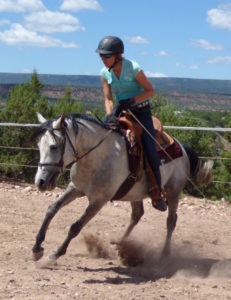Katrin Silva grew up riding dressage in Germany before moving to the United States at age 19 to learn to ride Western. She’s been riding both disciplines for the last twenty years. Read her article on Contact here.
Silva has competed successfully through fourth level dressage on quarter horses, Morgans, Arabians, Hanoverians, and many other breeds. Based in New Mexico, she enjoys improving horse-rider partnerships and firmly believes that good riding is always good riding, no matter which type of tack a horse is wearing. Check out her blog here.
By Katrin Silva
Good riding is always good riding. No matter what riding discipline, we have much more in common than it appears at first sight. All good riders develop a good seat.
But what is a good seat?
- A Good Seat is an independent seat.
We can’t expect our horses to carry themselves until we, their riders, carry ourselves. A good rider is in self-carriage, whether she is a hunter-jumper rider in two-point position or a Western rider sliding to a stop.
If we look at pictures of horses and riders in any discipline, there’s an easy way to figure out whether the rider is in self-carriage: Imagine the horse disappears suddenly, like in a Star Trek episode. Now, look at the rider: What happens when she hits the ground? Does she land on her backside?
During this transition, Julie would fall over backward . . .
Does she fall forward, face-first? Or does she remain standing, with both feet firmly planted on the dirt?
A few strides later, harmony is reestablished. (see second image)
Riders who land standing are in self-carriage. They are less likely to cause pain or discomfort to their horses. They are less likely to struggle for balance, or to hang on to the reins in a desperate attempt to feel secure.
We expect our horses to carry themselves, but we have to fulfill our part of the bargain before asking our partners to do the same.
A rider in self-carriage will have a better chance of staying on when young horses get a little scared or excited.
- A good seat is an effective seat
I don’t really like to use the adjective “correct” to describe a good seat. It sounds too much like there is only one ideal way to sit on a horse. But it depends on everything from body type to rider goals. A much more fitting adjective is “effective.”
There are many riders whose position in the saddle mimics what they’ve learned from their well-meaning instructors, yet their seat is anything but effective. Some riders have been told to sit up straight so often that they look like they have swallowed a broomstick. They are often so focused on maintaining their “correct” body position that they forget to breathe.
Others have heard that they need to relax completely and to avoid all tension at all cost. That’s good advice, but without a certain degree of elastic core engagement, these riders resemble spineless creatures carried around like so much dead weight. Either extreme is wrong and ineffective. Only an effective seat allows a rider to communicate with the horse.
Communication is a two-way process. An effective seat allows riders to feel what the horse is doing. It’s soft and following. The rider’s core is engaged but not tense; her core muscles tighten and release in rhythm with the horse’s back, picking up the signals it sends without static interference, and without causing discomfort to the horse. A good seat enables riders to link into a constant feedback loop between horse and rider.
An effective seat allows the rider to influence the horse in a controlled way via leg and rein aids. Ideally, this can happen on a more subtle level via the core muscles. The rider feels what the horse is doing, and requests changes of direction or gait primarily through the seat. Accomplished riders on responsive horses can look like they’re not doing anything. What a beautiful sight, like a couple dancing together.
There are varieties of a good seat when riders sacrifice this level of subtlety for added stability, comfort (their own or the horse’s), or a specific goal like getting out of the horse’s way when jumping an obstacle.
So, the search for the ideal seat must remain in vain. Trying to conform to someone else’s idea of the perfect position can be counterproductive because it keeps us from focusing on feel and communication. But a more independent, more effective seat is something every good rider spends a lifetime developing.





Just out of the blue I remembered my friend’s father telling my grandmother that I had a good seat. He was an owner and breeder of horses and I had just started riding with my friend (and her father) at 5yo. I love horses and it was apparent to everyone around us. I remember he would tell me to whip my horse if their horse I was riding was taking her time walking across a frozen river. However, I would never do that and I just leaned forward and made the clicking sound and felt I wanted to respect the horse’s apprehension walking on the ice and breaking through it. She was ‘Queenie’, 17 1/2 hands and a gorgeous, shiny chestnut color. I sensed she sensed me as well and I always treasured brushing her after riding and it brought us closer, I think. My grandmother asked about my horse riding ability year after year and this owner would always say, “She has a good seat.” I thought he was commenting on my butt and thought it was inappropriate. It wasn’t until today, 60 years later, that I just thought I would read your work and just see if u happen to mention that phrase and of course, u did ! Now I realize it was a very nice compliment from this very regimented, hard to please man and I thank u for educating me and making me feel very positive about something that initially made me feel a little uncomfortable! 😊